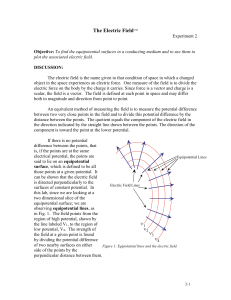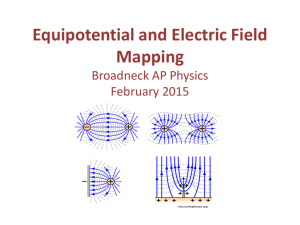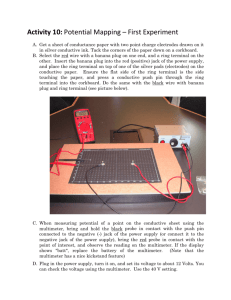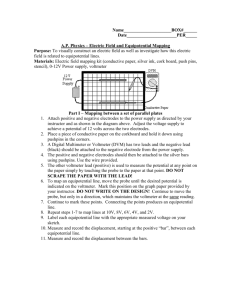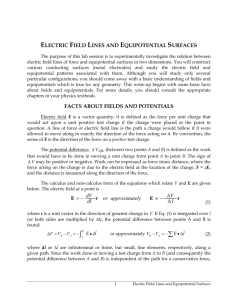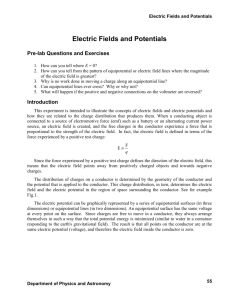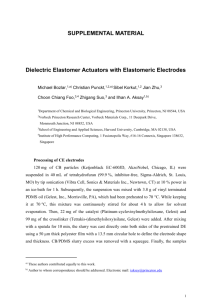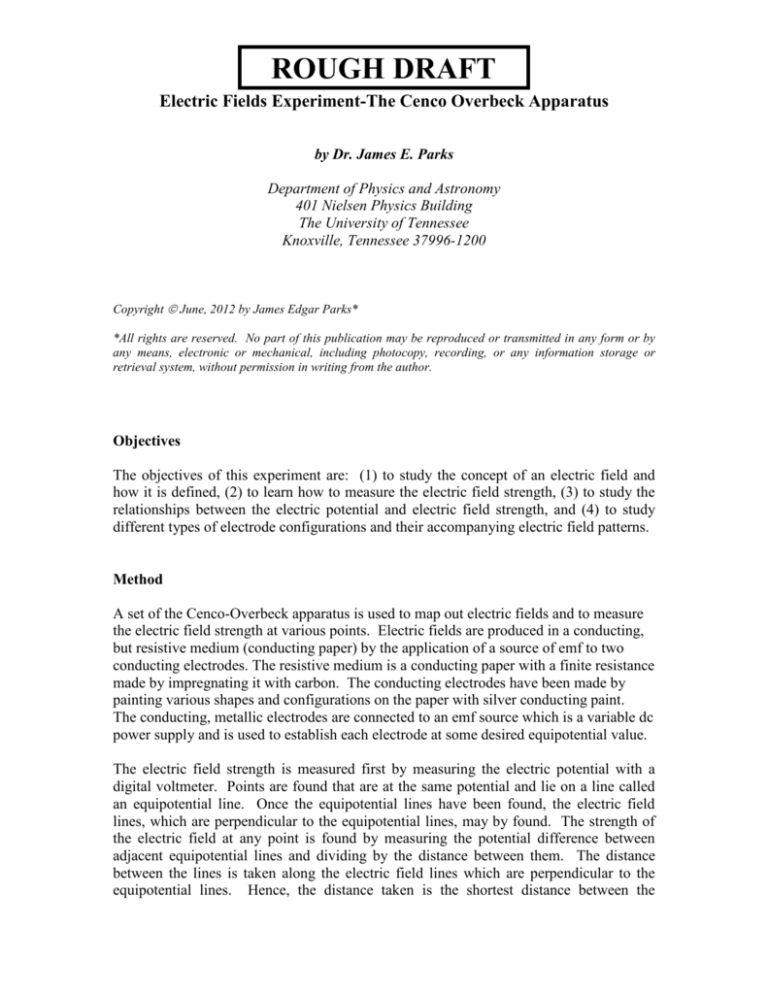
ROUGH DRAFT
Electric Fields Experiment-The Cenco Overbeck Apparatus
by Dr. James E. Parks
Department of Physics and Astronomy
401 Nielsen Physics Building
The University of Tennessee
Knoxville, Tennessee 37996-1200
Copyright June, 2012 by James Edgar Parks*
*All rights are reserved. No part of this publication may be reproduced or transmitted in any form or by
any means, electronic or mechanical, including photocopy, recording, or any information storage or
retrieval system, without permission in writing from the author.
Objectives
The objectives of this experiment are: (1) to study the concept of an electric field and
how it is defined, (2) to learn how to measure the electric field strength, (3) to study the
relationships between the electric potential and electric field strength, and (4) to study
different types of electrode configurations and their accompanying electric field patterns.
Method
A set of the Cenco-Overbeck apparatus is used to map out electric fields and to measure
the electric field strength at various points. Electric fields are produced in a conducting,
but resistive medium (conducting paper) by the application of a source of emf to two
conducting electrodes. The resistive medium is a conducting paper with a finite resistance
made by impregnating it with carbon. The conducting electrodes have been made by
painting various shapes and configurations on the paper with silver conducting paint.
The conducting, metallic electrodes are connected to an emf source which is a variable dc
power supply and is used to establish each electrode at some desired equipotential value.
The electric field strength is measured first by measuring the electric potential with a
digital voltmeter. Points are found that are at the same potential and lie on a line called
an equipotential line. Once the equipotential lines have been found, the electric field
lines, which are perpendicular to the equipotential lines, may by found. The strength of
the electric field at any point is found by measuring the potential difference between
adjacent equipotential lines and dividing by the distance between them. The distance
between the lines is taken along the electric field lines which are perpendicular to the
equipotential lines. Hence, the distance taken is the shortest distance between the
Electric Fields Experiment—The Cenco-Overbeck Apparatus
equipotential lines at the point of measurement and therefore is measured in a direction in
which the potential change is the greatest.
Theory
An electric field is defined as a space (field) in which if there is placed a small positive
test charge, there will be a force exerted on this test charge. The magnitude of the
electric field strength | E | is given by the ratio of this force F divided by the magnitude of
the charge q, i.e.,
F
E=
q
(1)
The electric field is a vector quantity whose direction is taken to be the direction that this
small positive test charge would move. Electric fields are produced by other charges or
charge distributions. These are in turn created by the separation of charges by some
electromotive force, emf, such as a battery or power supply. This is usually done by
applying the emf to two conducting electrodes. The geometries of the electrodes and
their relative positions determine the way in which the charges will be distributed on the
electrodes. The charge distribution then determines the electric field strength at various
points in space.
If the charge distributions are known, the electric field may be calculated using an
extension of Coulomb's law. However, the charge distributions are difficult to find.
While it is conceptionally easy to place a small test charge in an electric field and find the
force on it, it is not practical to do so. The electric field must be measured by other
indirect means, such as measuring the electric potential and using relationships between
electric potential and electric field strength. Electric potentials can be easily measured
with voltmeters if the input impedance of the voltmeter is high enough so that it doesn't
disturb the electric field in which it is placed.
The electric potential is best defined in terms of potential difference since the potential at
any point may be set arbitrarily to zero. A potential difference exists between two points
in an electric field when work is required to move a charge from one point in the field to
the other. The electric potential difference V between these two points then is defined as
the work W required to move a small positive test charge q from one point to the other
divided by the test charge, i.e.,
V=
W
q
(2)
The work and hence the potential difference between the two points is independent of the
path that is taken between the two points. Since the potential at one of the points may be
arbitrarily set equal to zero, the potential difference and potential at the other point are the
2
Electric Fields Experiment—The Cenco-Overbeck Apparatus
same. Using the basic definition of work, in which work W equals force F times distance
d or
W = F ⋅d ,
(3)
a relationship between the electric potential V and the electric field strength E can be
found. While work and potential difference are scalar quantities and are independent of
the direction and path that is taken, the electric field strength is a vector quantity and
depends on the direction of the force. Therefore, the relationship depends on the
direction of the force, so the relationship that is found between V and E must also be a
directional relationship. In Equation (3) work is a scalar quantity which is equal to the
product of two vectors. This scalar product, as it is called, means that the force and
distance, or their components, must be in the same direction before being multiplied
together. Care must be taken to insure that the integrity of the vector relationships are
preserved. A proper relationship between V and E may be found by substituting
Equation (3) into Equation (2) so that
F ⋅d
V=
.
q
(4)
Then by substituting Equation (1) into this result the potential difference is given by
qE ⋅ d
V=
q
(5)
or
V = E ⋅d.
(6)
If E and d are in the same direction, then
V = Ed
(7)
V
.
d
(8)
and
E=
For situations where the electric field is not uniform at different points in space, this
equation must be constrained to apply over a small increment of distance ∆d where the
change in potential is ∆V . Then the electric field strength is found by the following
equation
E=
∆V
.
∆d
3
(9)
Electric Fields Experiment—The Cenco-Overbeck Apparatus
Therefore, the electric field strength at a point may be found by measuring the potential
difference between two nearby points which lie along a line in the direction of the electric
field and dividing by the distance between these two points.
The SI unit of electric field strength is newton/coulomb and is equivalent to volts/meter.
More commonly, though, the electric field strength is measured in units of volts/cm, a
hybrid of cgs and SI units.
If a test charge were moved in a direction perpendicular to the electric field, no work
would have to be done in doing so. This means there would be no change in potential
and the charge would be moved along an equipotential line. Therefore, electric field lines
and equipotential lines are perpendicular. The potential undergoes no change in a
direction perpendicular to the electric field and undergoes a maximum change in a
direction parallel to the field.
Just For Those with an Understanding of Calculus:
The electric field's direction is parallel and opposite to the direction in which the electric
potential increases the most. In calculus, an operator called the gradient and symbolized
by ∇ is introduced to signify changes that must be made in a direction in which the
change is greatest. With this notation Equation (9) may be written in terms of calculus so
that
E = −∇V
(10)
∆V
Where ∇V =
lim
sˆ and ∆V is the change in potential, ∆s is the distance over
∆s → 0
∆s
which this change takes place, and s is the unit vector which is the direction over which
the change in potential is the greatest. The minus sign occurs because the electric field is
in the opposite direction to the direction in which the potential is increasing. The
symbols lim means that ∆s must be very small. Therefore,
∆s→0
∆V
E = − lim
∆s → 0
∆s
sˆ.
(11)
Apparatus
The equipment needed for this experiment is shown in Figure 1 and consists of the
following: (1) Cenco-Overbeck electric fields mapping apparatus with U-shaped
mapping probe, (2) sets of parallel, point, and circle electrode configurations painted on
conducting paper mounted to a substrate, (3) Pasco PI-9877 variable dc power supply,
(4) Meterman 15XP digital voltmeter, (5) banana plug connecting wires and (6) graph
paper, (7) ruler, and (8) pencil.
4
Electric Fields Experiment—The Cenco-Overbeck Apparatus
Figure 1. Electric fields experiment using the Cenco-Overbeck field mapping apparatus.
Procedure
1. The experiment will be performed first using a parallel electrode configuration. This
configuration yields a space in which the electric field is constant and is the easiest to
measure and understand.
2.
Examine the apparatus and make sure that it is wired as shown in Figure 1.The
apparatus consists of a board on the bottom of which the conducting paper mounted
substrate and parallel electrode configuration may be attached. The top side of the
board provides for the placement of a sheet of graph paper and has guide pins for the
positioning of a template that matches the postion of the electrodes on the bottom of
the board. The top portion of the board has a terminal on each side which is
connected to the two terminals on the bottom side that are attached to the two
conducting electrodes. A U-shaped probe provides a mechanism by which the
potential may be measured by contacting the conducting paper on the bottom. The
corresponding position may then be recorded on the graph paper on the top.
5
Electric Fields Experiment—The Cenco-Overbeck Apparatus
Figure 2. Schematic diagram for electric fields experiment.
3. Turn the digital voltmeter on to the DCV range. (Turning the voltmeter on while
holding the range button in and still holding for 2 seconds afterwards, will prevent the
voltmeter from turning itself off to save power.) Adjust the precision of the readings
by repeatedly pushing the range selection button until the range shows only a 0.1 volt
precision, i.e. the voltmeter reading rounds off to the nearest 0.1 volt. Using higher
precisions for exampleCheck that the digital voltmeter is wired as shown in Figure 2,
so that it measures the electrical potential between ground and the free, hand-held
probe which will be used to measure the electric potential at various points in the
resistive medium. Make sure the digital voltmeter is on and is set to measure a
voltage. The range of the voltmeter should be set to measure 0 to 10 volts to a
precision of 0.1 volts. The range can be changed by repeatedly pushing the range
button and observing the position of the decimal point in the display.
4. Obtain a sheet of graph paper (large 1 cm divisions is best) and attach it to the top of
the board. The feet of the board are spring loaded so that if you push down on each
corner of the board, a rubber pad will rise up so each corner of the graph paper may
be inserted and held down when the spring is allowed to return to its normal position.
Sometimes the rubber pads don't hold well so it is advisable to use a piece of masking
tape as insurance against the paper moving during the experiment.
5. Position the clear plastic template over the positioning pins and trace the out­line of
the parallel electrodes. If this can't be done using a colored fiber tipped pen so that it
stands out, shade the electrodes with pencil or ink. Remove the template.
6. Position the U-shaped probe so that it is between the electrodes near the center. When
readings are being made with the probe, it should be squeezed together slightly. Care
6
Electric Fields Experiment—The Cenco-Overbeck Apparatus
should be taken to make sure no shearing stresses are placed on the probe and that the
probe's indicating circle and contact point are always directly opposite each other.
7. Turn on the power supply and adjust the voltage until the digital voltmeter reads
about 5 volts. Make sure the probe is making good contact while doing this.
8. Move the probe left and right and note how the voltage changes.
9. Move the probe to and from you and note how the voltage changes.
10. Note the directions in which the potential increases and decreases the most and the
least. Record the observations.
11. Move the probe to the left electrode and note that the potential there is zero. Also note
that the potential is zero at every point on the conducting electrode. This results from
the arbitrary choosing of the zero point and was done by connecting the ground side
of the voltmeter to this electrode. Ground potential is customarily zero.
12. Move the probe to the right electrode and note its potential. Also note that the
potential is the same at every point on the electrode. Re-adjust the power supply so
that the electrode's potential is 10 volts.
13. Move the probe around until you find a point at one volt potential. Circle that point
and repeat this procedure many times until you can construct with certainty the one
volt equipotentia1 line. Don't be afraid to go around behind the electrodes to measure
the potential and find points. Connect the points with a solid line.
14. Repeat the previous step for the 2, 3, 4, 5, 6, 7, 8, and 9 volt equipotential lines.
15. Draw continuous dotted lines perpendicularly to the equipotentia1 lines and indicate
the direction of the electric field lines.
16. Have your instructor designate points on your graph at which you are to calculate the
magnitude of the electric field strength.. Label them as A, B, C, ….
17. Calculate the electric field strength at one of the indicated points by moving a little
distance (less than 0.5 cm) to the left along the electric field line and a little distance
to the right along the electric field line. Record the electric potential at each of these
adjacent points and find their difference, ∆V. Measure the distance between the two
points to find ∆s. Calculate the electric field strength by dividing ∆V by ∆s. Repeat
for each of the other points. Record your results for the points A, B, C, ….
18. What observations can you make concerning the electric field ih between the parallel
plates and outside the plates?
19. Repeat the experiment for another electrode configuration.
7
Electric Fields Experiment—The Cenco-Overbeck Apparatus
20. After you have completed the experiment, turn off the power supply and the digital
voltmeter.
Questions
1. If the potential is the same everywhere on the conducting electrodes, what is the
electric field strength in each electrode?
2. If a volt is joule/coulomb, show that a newton/coulomb and a volt/meter are
equivalent.
3. Why is it not possible for two different equipotential lines to cross?
4. Under what conditions will the field between the electrodes of a parallel plate
configuration be uniform?
5. Why are the equipotential lines near a conducting surface parallel to the surface?
Hint: Since charges are free to move on a conductor, the electric field near a
conductor is perpendicular to the conductor's surface.
6. Describe how a uniform electric field might be used to measure distance. Hint: In
the parallel electrode arrangement, what parameter(s) varied with distance between
the electrodes and what parameter(s) stayed constant?
8

